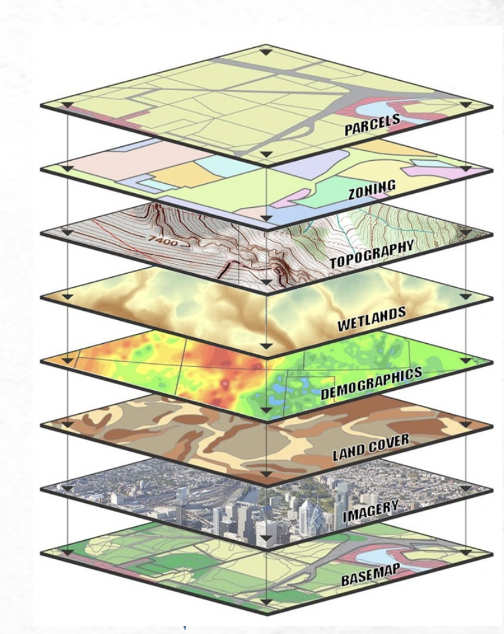GIS data comes in many shapes and formats, and ArcGIS Pro supports a wide variety of data formats that can be used as sources for layers in your mapping projects. While ArcGIS Pro works with numerous formats, geodatabases represent the cornerstone of efficient data management in the Esri ecosystem. This guide will walk you through the various data formats compatible with ArcGIS Pro, with special emphasis on geodatabase formats.
Geodatabase Formats: The Foundation of ArcGIS Pro
Geodatabases are Esri’s native data structure and the recommended format for ArcGIS Pro projects. They offer superior performance, data management capabilities, and advanced functionality that other formats simply can’t match.
File Geodatabase (.gdb)
The File Geodatabase is Esri’s primary format for storing and managing GIS data, offering the perfect balance between performance and accessibility. It’s designed as a collection of files in a folder system where each dataset is held as a separate file, allowing for efficient access and management.
Pros:
- Handles large datasets efficiently (up to 1TB per dataset)
- Supports complex data models, relationships, and topologies
- Stores multiple feature classes, tables, and rasters in one container
- Advanced attribute handling (long field names, domains, subtypes)
- Versioning capability for multiuser editing (through branch versioning)
- Significant storage efficiency (typically 1/3 the size of shapefiles)
- Superior performance with large datasets
- Support for compressed and read-only data
- Maintains data integrity through constraints and validation rules
- Enables attachment storage for features
- Supports feature-linked annotation
Implementation Benefits:
- Organization: Related datasets are logically grouped together
- Performance: Optimized indexing for spatial and attribute queries
- Scalability: Grows efficiently as projects expand
- Security: Can apply permissions at multiple levels
- Integration: Seamless operation with ArcGIS geoprocessing tools
Cons:
- Primarily designed for Esri products
- More complex to share with non-Esri users
- Directory-based structure can be accidentally modified outside of ArcGIS
Best Use Cases:
- Standard project data management
- Large dataset storage and analysis
- Complex data modeling requirements
- Long-term data archives
- Field data collection with disconnected editing
Enterprise Geodatabase
The Enterprise Geodatabase represents the most robust implementation of the geodatabase model, built on commercial database systems like SQL Server, Oracle, or PostgreSQL.
Pros:
- Full multiuser editing capabilities with traditional versioning
- Enterprise-level security and access control
- Virtually unlimited storage capacity
- Integration with organization-wide IT infrastructure
- Support for long transactions and complex workflows
- Archiving and historical tracking capabilities
Cons:
- Requires database administration expertise
- More expensive implementation
- More complex setup and maintenance
Other Vector Data Formats
While geodatabases are the preferred format, ArcGIS Pro works with many other vector formats for various workflows.
Shapefile (.shp)
The Shapefile format, developed by Esri, has been the workhorse of GIS data for decades. Despite its age, it remains one of the most widely used formats due to its simplicity and compatibility.
Pros:
- Widely supported across platforms
- Simple structure
- Fast rendering for smaller datasets
Cons:
- Field names limited to 10 characters
- 2GB size limitation
- Multiple files required (.shp, .shx, .dbf, etc.)
GeoJSON (.geojson, .json)
GeoJSON is an open standard format based on JavaScript Object Notation (JSON). It’s particularly popular for web mapping applications and APIs.
Pros:
- Human-readable text format
- Excellent for web applications
- Widely supported in programming environments
- Self-contained (geometry and attributes in one file)
Cons:
- Less efficient for large datasets
- Can become unwieldy for complex data
KML/KMZ (.kml, .kmz)
Keyhole Markup Language (KML) was developed for Google Earth but is now widely supported across platforms. KMZ is simply a compressed version of KML.
Pros:
- Excellent for visualization and sharing
- Well-supported across platforms
- Good for 3D representation
- KMZ offers compressed file size
Cons:
- Limited attribute capabilities
- Not ideal for analytical work
Raster Data Formats
Raster data represents geographic features as a matrix of cells in a continuous surface. These formats are ideal for phenomena that vary continuously, such as elevation or temperature.
GeoTIFF (.tif, .tiff)
GeoTIFF is a TIFF file with embedded geographic information. It’s the standard for raster data in GIS.
Pros:
- Industry standard for geospatial raster data
- Supports various compression methods
- Handles large datasets
- Preserves data quality
Cons:
- Can create large files without compression
ERDAS IMAGINE (.img)
Developed by Hexagon Geospatial, the ERDAS IMAGINE format is specialized for remote sensing data.
Pros:
- Efficient for large raster datasets
- Good for multispectral imagery
- Supports multiple bands efficiently
Cons:
- Less universal than GeoTIFF
JPEG 2000 (.jp2)
JPEG 2000 provides efficient compression while maintaining good image quality, making it suitable for aerial and satellite imagery.
Pros:
- Excellent compression rates
- Maintains good image quality
- Supports both lossy and lossless compression
Cons:
- Slower processing than some other formats
MrSID (.sid)
Multi-resolution Seamless Image Database (MrSID) provides high compression rates while maintaining image quality, ideal for large aerial photography.
Pros:
- Very efficient compression
- Fast display at multiple resolutions
- Excellent for very large datasets
Cons:
- Proprietary format
- Limited editing capabilities
Tabular Data Formats
Tables can be joined to spatial data or used as standalone data sources in ArcGIS Pro.
Comma-Separated Values (.csv)
CSV files are simple text files with values separated by commas, easy to create and edit in spreadsheet applications.
Pros:
- Universal compatibility
- Simple to create and edit
- Small file size
Cons:
- No native spatial component (requires XY data or joins)
- Limited data type enforcement
Microsoft Excel (.xlsx, .xls)
Excel spreadsheets can be imported directly into ArcGIS Pro.
Pros:
- Widely used business format
- Support for multiple worksheets
- Formatting and formula capabilities
Cons:
- Size limitations
- No native spatial component
Database Tables (SQL Server, Oracle, PostgreSQL)
Enterprise database tables can be connected to ArcGIS Pro directly.
Pros:
- Enterprise-level data management
- Multiple user access
- Advanced data integrity controls
- Can handle very large datasets
Cons:
- Requires database administration skills
- More complex setup
Specialized Formats
LiDAR Data (.las, .laz)
LiDAR point cloud data represents 3D elevation information.
Pros:
- Precise 3D information
- High-resolution elevation data
- Can classify ground, vegetation, buildings, etc.
Cons:
- Large file sizes
- Specialized processing requirements
CAD Formats (.dwg, .dxf)
Computer-Aided Design formats from AutoCAD and similar programs.
Pros:
- Direct interoperability with engineering designs
- Precision drawing elements
- Layered structure
Cons:
- Often needs cleanup for GIS use
- Attribute limitations
BIM (Building Information Model)
Building Information Models provide detailed 3D information about structures.
Pros:
- Highly detailed 3D structural information
- Contains rich attribute data
- Supports facility management
Cons:
- Complex data structure
- Specialized use cases
Web Services
ArcGIS Online/Portal Services
Web services hosted on ArcGIS Online or Portal for ArcGIS.
Pros:
- No local data storage required
- Always up-to-date
- Shared resources across organizations
Cons:
- Requires internet connection
- Potential usage credits
WMS/WMTS (Web Map Services)
Standard OGC web services for map imagery.
Pros:
- Industry standard
- Works across platforms
- No local data storage needed
Cons:
- Limited to predefined symbology
- Generally slower than local data
WFS (Web Feature Services)
Standard OGC services for vector features.
Pros:
- Access to actual feature geometry and attributes
- Supports editing (WFS-T)
- Cross-platform compatibility
Cons:
- Can be slower for large datasets
- More complex than WMS
Best Practices for Choosing Data Formats
When deciding which format to use for your ArcGIS Pro projects, consider:
- Default Choice: For most ArcGIS Pro workflows, start with File Geodatabase as your default format – it offers the best balance of performance, functionality, and ease of use.
- Enterprise Needs: When multiple editors need simultaneous access, or when integration with organizational IT systems is required, upgrade to Enterprise Geodatabase.
- Data Size: For large datasets (>1GB), geodatabase formats will significantly outperform shapefiles and most other formats.
- Advanced Functionality: When you need domains, subtypes, topology rules, network datasets, or other advanced data modeling capabilities, geodatabases are the only format that fully supports these features.
- Sharing Requirements: If sharing with non-ArcGIS users is a priority, consider exporting to open formats like GeoPackage, Shapefile, or GeoJSON at the end of your workflow.
- Performance Considerations: Local geodatabase data generally performs better than web services, particularly for complex analysis operations.
- Data Integrity: When data quality and referential integrity are critical, geodatabases offer validation rules and constraints that aren’t available in simpler formats.
Converting Between Formats
ArcGIS Pro provides several tools for converting between data formats:
- Feature Class to Feature Class tool for vector data conversion
- Raster to Different Format tool for raster data
- Table to Table tool for tabular data
- Export Features tool accessible via right-click menu for quick conversions
Conclusion
Understanding the various data formats available in ArcGIS Pro is crucial for efficient and effective GIS work. While ArcGIS Pro supports an impressive array of formats, geodatabases stand out as the clear choice for serious GIS work in the Esri ecosystem.
The geodatabase format represents Esri’s decades of experience in GIS data management, offering unmatched performance, scalability, and functionality. For most ArcGIS Pro users, establishing workflows centered around geodatabases—particularly File Geodatabases for individual work and Enterprise Geodatabases for team environments—will yield the best results and future-proof your projects.
That said, ArcGIS Pro’s flexibility in supporting numerous formats ensures you can incorporate data from virtually any source. This inclusivity allows you to maintain geodatabase-centered workflows while still collaborating across platforms and with external stakeholders.
As GIS technology continues to evolve, new formats and standards emerge, but the geodatabase remains at the heart of the ArcGIS platform. By understanding when to use geodatabases and when to leverage other formats for specific purposes, you can optimize your GIS workflows and take full advantage of ArcGIS Pro’s powerful capabilities.

